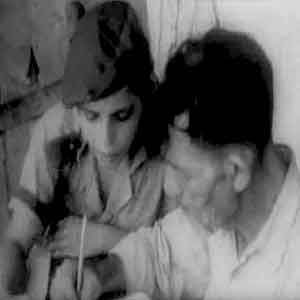By the early 1900s Cuba had a strong educational system, but it was only attended by half of the country's children.
Schools were not accessible to the poorest Cubans and this resulted in a low literacy rate for the country compared to the city.
Prior to 1959, of the Cubans over the age of 15 years, 22% were found to be illiterate and 60% of the country was found to be semi
illiterate because many rural Cubans had a third-grade education or less.
After the Cuban Revolution, the new government placed the reconstruction of the education system as a top priority.
A list of five key objectives was devised and used to frame Cuba's educational system. Elementary school became mandatory
and more importantly available for all children. Many children who lived in poverty were now able to acquire an education for
free providing them with an opportunity that eluded them prior to the revolution.
School attendance is compulsory from ages 6 to 15 or 16 (end of basic secondary education) and all students, regardless of age or
sex, wear school uniforms with the color denoting grade level. Primary education lasts for six years. Secondary education is divided
into basic secondary education and pre-university secondary education. The curriculum in primary and secondary schools is based upon
principles of "hard work, self-discipline and love of country".
 The Literacy Campaign was created to increase Cuba's literacy rate
and also to initiate communication between the country and city. Students and volunteers went to rural areas to teach other
country men to read and provide information on current Cuban politics. Rural women received schooling and job training if they
choose to, which allowed them to work outside of agriculture. For women working as prostitutes in the cities the New Government
created programs to re-educate them once prostitution became illegal in 1961.
The Literacy Campaign was created to increase Cuba's literacy rate
and also to initiate communication between the country and city. Students and volunteers went to rural areas to teach other
country men to read and provide information on current Cuban politics. Rural women received schooling and job training if they
choose to, which allowed them to work outside of agriculture. For women working as prostitutes in the cities the New Government
created programs to re-educate them once prostitution became illegal in 1961.
At the end of basic secondary education, pupils can choose between pre-university education and technical and professional education.
Those who complete pre-university education are awarded the Bachillerato. Technical training leads to two levels of qualification -
skilled worker and middle-level technician. Successful completion of this cycle gives access to the technological institutes.
Higher education is provided by universities, higher institutes, higher pedagogical institutes, centres of higher education and
higher polytechnic institutes. All higher education institutions are public. The Ministry of Higher Education (Ministerio de
Educacion Superior (MES)) is responsible for policy in matters of undergraduate and postgraduate education. It controls teaching,
methodology, courses and programs and the allocation of student places, as well as the specialization courses offered by centres of
higher education that come under the control of other ministries. All institutions have the same status. Cuba has 47 universities
and total university enrolment is approximately 112,000 citizens.
Cuba also provides state subsidized education to foreign nationals under specific programs, including U.S. students who are
trained as doctors at the Latin American School of Medicine. The program provides for full scholarships, including accommodation,
and its graduates are meant to return to the US to offer low-cost healthcare.
A 1998 study by UNESCO reported that Cuban students showed a high level of educational achievement.
Cuban third and fourth graders scored 350 points, 100 points above the regional average in tests of
basic language and mathematics skills.
The report indicated that the test achievement of the lower half of students in Cuba was significantly higher
than the test achievement of the upper half of students in other Central and South American countries in the study group.
How does Cuba literacy rate compare?
Literacy rates of 15-24 years old, both sexes, percentage. Higher is better. Year 2008
Cuba 100% |
Argentina 99.10% |
Mexico 98.40% |
Brazil 97.80% |
Colombia 98.00% |
Honduras 93.90%
Select your authentic Cuba trip from over 70 Cuba tours in seconds. Sort by departure date, price, destination and even Cuba travel theme.
QUICK CUBA TOUR FINDER